Telmex, Telnor and Telcer must publish reference offers of wholesale services for this month (Press Relase 56/2014)
Telmex, Telnor and Telcer must publish reference offers of wholesale services for this month
• The Federal Telecommunications Institute reported on Friday, November 7th its resolution to the Preponderant Economic Agent (PEA) in telecommunications, who must publish it no later than 21st of this month
• The companies have 15 days to sign the agreements with concerned concessionaires, having made the request
• These measures will allow to those different to the PEA Concessionaires to have access to infrastructure in better conditions of competition for the benefit of the users
On Friday November 7th, companies that constitute the Preponderant Economic Agent (PEA) in the telecommunications sector (América Móvil, Grupo Financiero, Grupo Carso, Telmex and Telnor), were notified of Reference Offers of wholesale services approved unanimously by the Plenary of the Federal Telecommunications Institute (Instituto Federal de Telecomunicaciones, IFT) at its Sixteenth Ordinary Session, two days before.
Not later than November 21st, such companies must publish the Reference Offers, which establish the specific terms and conditions under which they should provide wholesale telecommunications services and allow access to its infrastructure to other concessionaires and providers of these services in better competition conditions for users. With these offers, which will be valid until December 31th, 2015, concessionaires PEA competitors will have the necessary information to make decisions about the marketing of wholesale telecommunications services.
Additionally, Reference Offers must meet the criteria in the Fixed and Mobile Measures of Preponderance Resolution, this points out among other things, that the Offers must not contain discriminatory or abusive conditions in the provision of services, nor should condition its provision or create unnecessary requirements for the service delivery of these.
This ensures that applicant concessionaires to compete with the PEA in providing retail services in terms of quality, added value services and rates, among others, thereby benefiting the end user.
The Reference Offers apply to the following services:
1) Marketing service or resale by the Mobile Virtual Network Operators
The marketing of PEA mobile telecommunications services (voice, SMS and data) is opened to companies known as Mobile Virtual Network Operators (MVNOs), which do not have spectrum.
2) Access and Passive Infrastructure Sharing in Mobile Networks and Fixed Networks
It will allow concessionaires of public telecommunications networks to set up their own infrastructure, taking advantage of unused capacity of PEA mobile and fixed networks.
3) Wholesaler Service of Visitor User
Will enable mobile telecommunications concessionaires other than PEA, to expand the geographical coverage of its services, for example, in regions where they do not have coverage.
5) Wholesaler Service of Leasing of Dedicated Links
It will provide a tool to regulate the provision of relevant wholesale service, including dedicated links, which serve as essential input for the provision of other telecommunications services.
It should be noted that PEA has 10 working days from notification to publish the Reference Offers on its website and to give notice of the thereof issuance in two newspapers of national circulation.
The PEA is required to sign agreements with concessionaires that ask for the provision of those services on 15 working days after being made the request.
Reference Offers are the contractual framework that provides certainty to PEA and services applicants, and promote more effective competition in the telecommunications sector.
With the approval of these Reference Offers and its subsequent application, the IFT monitors the implementation of the various specific measures to be met by the PEA, according to the legal mandate of this regulatory body.
Erratum: In the second paragraph of this press release it says "Not later than November 21st such companies must publish Reference Offers, which establish the specific terms and conditions under which should provide wholesale telecommunications services and allow access to its infrastructure to other concessionaires and providers of these services at better conditions of competition in favor of users."
However, in the calculation of the days it was not considered that on Monday 17th, November is a non-business day, so that the aforementioned period is not the Nov. 21st, but 24th of this month.
Documentos para descargar
Temas relacionados
The Plenary of the Federal Telecommunications Institute approved to submit for public consultation the “proposed draft guidelines for collaboration on security and justice matters” (Press Release 55/2014)
• Is submitted for public consultation on the principles of transparency and citizen participation, in terms of the provisions of the Law
• The document contains the mechanisms of interaction between telecommunications enterprises and security agencies and law enforcement cooperation to be effective and timely
• In the Draft guidelines not only the provisions of the Law are followed, also respect for human rights and protection of privacy and personal data of users
• At no time record retention or content of communications is established
• It is proposed to establish special service code 066 (ZERO, SIX, SIX), as the only nationally harmonized numbers for the provision of emergency services
New rules of number portability issued by the IFT remove requirements and users can exercise this right in a faster an agile manner (Press Release 54/2014)
New rules of number portability issued by the IFT remove requirements and users can exercise this right in a faster an agile manner
The Federal Institute of Telecommunications (Instituto Federal de Telecomunicaciones, IFT) Plenary issued today new rules for number portability, which will allow users of fixed and mobile telephony that wish to switch from provider retaining their phone number to do so more easily and quickly.
Thus, the IFT comply in a timely manner with its legal mandate to issue, within 60 working days of the publication of the Federal Telecommunications and Broadcasting Law, administrative rules needed to eliminate requirements that may delay or prevent number portability and thereby enable users to realize this process in a maximum of 24 hours.
Number portability is the right of users to choose the telephone company that offers the best conditions of service, and to change this as many times as the user wants to, but without losing her/his phone number, and over 17 million lines in Mexico have exerted from 2008, year in which this mechanism was implemented. Now, the IFT issues new rules for effective portability, with fewer steps and in less time than it currently takes to perform this process.
In this regard, it is important to consider that to implement these new provisions, the telephone service concessionaires must meet a series of actions and technical procedures in their networks and equipment, including supporting evidence, and changes to plans marking and numbering. However, while the various steps required are depleted to develop new systems —what should occur no later than 90 calendar days—, the rules provide that a publication from the day:
• The requirement applied to users of fixed and mobile lines to present postpaid bill and contract, requiring only the submission of an official identification and expression of will of the applicant is deleted.
• Only a user ID and his/her consent is required.
• Deadlines are reduced: the portability of both fixed and mobile lines in any form will be made no later than 3 days.
The new measures mentioned shall apply immediately, once published in the Federal Official Gazette (Diario Oficial de la Nación, DOF) the Agreement by which the IFT Plenary issued the rules of number portability. Also, within 90 calendar days for the entry into force of these rules is established, counted from publication in the Federal Official Gazette. This period will allow executing the following actions strictly necessary for the porting process to reach the goal of 24 hours without compromising the continuity of communications:
• In 5 calendar days: Convene and constitute a Technical Committee in matters of portability, numbering and signaling, involving all service providers with numbers assigned to design the technical specifications and Operational specifications for implementing portability in the country, so it is achieved in an orderly and coordinated manner.
• In 10 calendar days: new technical parameters that apply to the processes of communication and information exchange between systems companies participating in the process of portability must be defined.
• In 60 calendar days: to make adjustments and develop technical solutions to enable communication and interoperability between operating systems providers of telecommunications services and the Administrator of the database.
• In 15 days: in order to verify the correct performance of the adaptations and new functionalities of the systems of telephone companies and the Administrator of the Data Base the necessary tests should be performed.
Meeting these deadlines will implement portability effectively, as stipulated by Law, and according to international best practices.
Upon completion of these stages (within a maximum period of 90 calendar days), users wishing to port their numbers may make number portability with additional benefits to those already mentioned:
• The user will have the possibility to directly collect all the requirements for starting the process of portability and not depend on a provider to complete the process.
• All users can port the number in a maximum of 24 hours.
• A PIN (Personal Identification Number) confirmation will be given to validate the willingness of users in portability to all users, including fixed service and mobile postpaid.
• You can keep your same number if you move to another city (with the same company or with another provider, as selected).
• Just present an ID and manifestation of the will of the user.
• A system is instrumented so that the user can keep track of your application porting by dialing 051.
• In case telephone lines are corporate entities, holders must verify that the bearing is requested by the representative or legal guardian.
• Traders will be directly involved in the processes of portability.
• Concessionaires will be responsible for the costs of upgrading network elements and systems to allow portability.
With the issuance of these rules, the provisions of Article Thirty-Eighth Transitory Decree which was issued the LFTR, but more importantly, the necessary measures for making effective rights of the users which has been the axis rector of the performance of IFT since its integration, are complied.
Documentos para descargar
Temas relacionados
IFT Plenary approves the wholesale services of reference that Telmex, Telnor and Telcel must apply (Press Release 53/2014)
IFT Plenary approves the wholesale services of reference that Telmex, Telnor and Telcel must apply
• This conditions imposed to the Preponderant Economic Agent will give access to its competitors to its infrastructure in non-discriminatory and fair conditions
• Imply measures related to Virtual Mobile Operators, access and shared use of telecommunications infrastructure and user/visitor wholesale service, among others
• A prompt following takes place for the implementation of different specific measures that PEA (Preponderant Economic Agent) must accomplish, pursuant to the legal mandate conferred to this body of law
• It agrees to submit the document “Review of Guidelines for the development of cost models that supports the determination of applicable rates to interconnection services”1 for public consultation
• The procedure was declared deserted when no proposals were received for Public Bidding grant of concessions to occupy geostationary orbital positions 113° West and 116.8° West
In compliance with the terms foreseen in the measures imposed by the Federal Telecommunications Institute (Instituto Federal de Telecomunicaciones, IFT) to the Preponderant Economic Agent (Agente Económico Preponderante, AEP) in the telecommunications sector (Telmex, Telnor and Telcel), the Plenary of this regulatory body authorized the Reference Offers which contain the specific terms and conditions under which this companies must provide telecommunications wholesale services and concede access to its infrastructure to other concessionaires. This will allow telecommunications services to be rendered in fair competition circumstances.
This is the Reference Offers of the following services: 1) Service marketing or resale by the Mobile Virtual Network Operators; 2) Access and Shared Use of Passive Infrastructure on mobile networks;
3) Wholesale Service User/Visitor; 4) Access and Shared Use of Passive Infrastructure on fixed networks), and 5) Wholesale Service of Dedicated Links Leasing.
In accordance with the provisions Prevalence measures, the Institute conducted a review of the above Reference Offers, a process that began on June 4th this year, with the first proposal by the PEA (Preponderant Economic Agent) and concludes with the authorization of the Institute's Plenary, after a process of analysis and requirements of modifications, that was attended by the PEA.
Thus, at the session held today, the IFT Plenary agreed to approve the Reference Offers, these will enable the effective delivery of different wholesaler services under the Preponderance Resolution, by having a contractual framework giving certainty to PEA and to applicants for services, thus promoting more effective competition in the telecommunications field.
With this, the IFT gives timely monitoring to the implementation of the various specific measures to be met by PEA, according to the legal mandate of this regulatory body.
Among the conditions that PEA must meet in reference offers, the following are included:
1) Mobile Virtual Network Operators (MVNOs). It will allow the marketing of PEA mobile telecommunications services (voice, SMS and data) by companies known as Mobile Virtual Network Operators, which do not have spectrum but can be more efficient in other aspects of the production chain, invigorating this sector, bringing the benefits of competition to end users.
2) Access and Mobile Infrastructure Sharing. It will allow other concessionaires of public telecommunications networks to set up their own infrastructure, leveraging unused capacity of PEA mobile networks, thereby decreasing the costs of deploying of networks and promoting the realization of economies through more efficient use of existing infrastructure.
3) Guest User (Roaming). It will allow other mobile telecommunications concessionaires to expand its geographical coverage in the services offered, for example, in regions where it does not have coverage yet.
4) Access and Shared Use of Fixed Infrastructure. It will allow other concessionaires of public telecommunications networks to set up their own infrastructure leveraging unused fixed networks of PEA, thereby decreasing costs of network deployment and promoting the realization of economies through more efficient use of existing infrastructure.
5) Wholesaler Service of Dedicated Links Leasing. It will provide a tool to regulate the provision of a wholesale service of great importance, as are dedicated links, to serve as essential for the provision of other telecommunications services; whereby concessionaires can be certain of receiving services under non-discriminatory conditions of quality and price and aligned with international standards.
The PEA shall publish on its website and give notice of the issuance of tenders in two newspapers of national circulation within 10 working days of resolutions being notified.
On the other hand, the IFT Plenary agreed to submit to public consultation the document entitled "Revision of the Guidelines for developing cost models" for the determination of the applicable interconnection services rates.
With this transparency exercise, not only the provisions of the Federal Telecommunications and Broadcasting Law, in the sense of public consultation for the issuance or modification of guidelines and general provisions are provided, but that citizen participation is also promoted in knowing the comments and views of stakeholders on the issue and, if appropriate, to incorporate them to strengthen the project that will be submitted for the Plenary consideration in due course.
The Guidelines that were issued in April 2011 by the former Federal Telecommunications Commission (Comisión Federal de Telecomunicaciones, Cofetel) are still in force. However, with technological change and reviewing the best international practices in cost models, it is necessary to review new regulatory approaches for determining interconnection fees.
The document will be available to all stakeholders for consultation on the website of the Institute. The period to participate in this exercise is from 6th to 21st November this year. The Plenary of the Institute also declared void the Public Bidding procedure for granting concessions to occupy geostationary orbital positions 113 °West and 116.8 °West and to exploit frequency bands C associated and Ku extended, as well as the allowances for emission and reception of signals in the provision of satellite capacity for fixed-satellite service (IFT-2).
This, because the only bidder that requested and received the favorable opinion of the Institute on economic competence to participate in the IFT-2, not presented the documentation referred to in Appendix A of the Tender terms, which included bid security and economic offer and guarantee of orbital positions occupation with its Band of Associated Frequencies as well as the documentation that confirmed the favorable opinion on economic competition before the deadline.
Whenever the market indicated no appetite for participating in the tender for these orbital positions, and based on Article 95 of the Federal Law on Telecommunications and Broadcasting (Ley Federal de Telecomunicaciones y Radiodifusión, LFTR), which includes the assumptions why a tendering procedure may be declared desert, in this case to grant concessions to occupy orbital resources, the IFT Plenary determined to take the indicated resolution.
Mexico may request to the International Telecommunications Union (ITU) the coordination of other orbital positions with similar or different from these orbital locations technical parameters at any time, and even, in accordance to the provisions of Articles 96 and 97 of the Federal Law on Telecommunications and Broadcasting, individuals can now express their interest to the Institute for the Federal Government to obtain orbital resources to the Mexican State. In that case, and prove favorable coordination process, the Institute shall award the grant directly to the stakeholder on payment of the appropriate consideration.
1 Translator's note: “Revisión de los Lineamientos para desarrollar modelos de costos que sirvan para la determinación de las tarifas aplicables a los servicios de interconexión”.
Documentos para descargar
Temas relacionados
The Federal Telecommunications Institute announces the evolution of telecommunication services in the second quarter of 2014 (Press Release 52/2014)
The Federal Telecommunications Institute announces the evolution of telecommunication services in the second quarter of 2014
• The rates of mobile phone service and Internet decreased 9.1% and 4.6% respectively
• The base of mobile phone service reached 103.9 million subscriptions
• The international long distance traffic recorded an increase of 3% over the same quarter in 2013
• Restricted TV service reached a total of 15.4 million subscriptions, driven by growth of 0.27% in the segment of cable and 13.79% for satellite, over the same period in 2013
Currently, the Federal Telecommunications Institute (Instituto Federal de Telecomunicaciones, IFT) is in the process of redesigning systems for collecting and processing information for integrating metrics and statistics of regulated sectors, based on the powers that were granted in the Federal Telecommunications and Broadcasting Law (Ley Federal de Telecomunicaciones y Radiodifusión, LFTR) and recently entered into force. Meanwhile, the IFT will continue publishing industry statistics based on the methodology applied to date. In this context, for the second quarter 2014 the report is submitted.
Mobile Telephony
The mobile telephony service recorded an increase of 2.5% in the minutes of tracked network traffic during the second quarter of 2014 (see Figure 1). During this quarter, 1.34 million subscriptions were added, which represented a 1.3% increase over the same period last year.
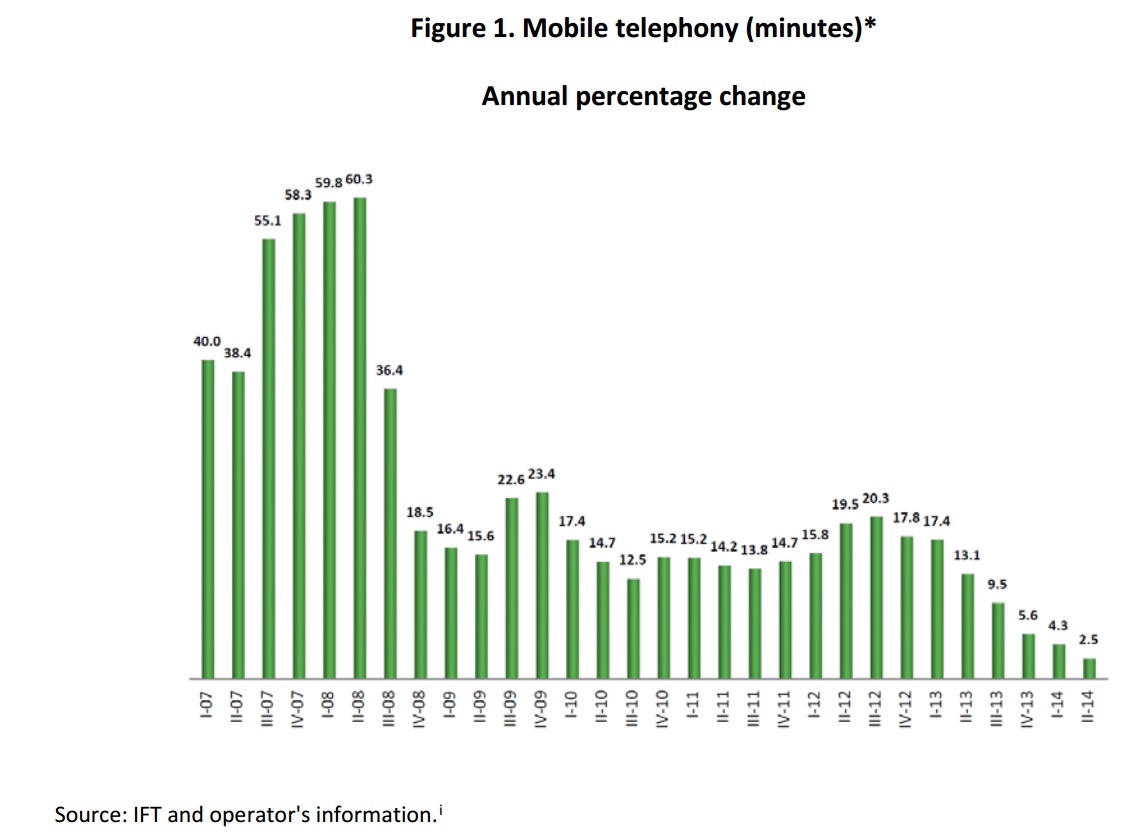
In relation to the number of mobile phone subscriptions, one upward trend is observed when compared with the same period last year, from 102.6 to 103.9 million (see Figure 2). At the end of the second quarter a density of subscriptions was reached 86.8 per 100 inhabitants.
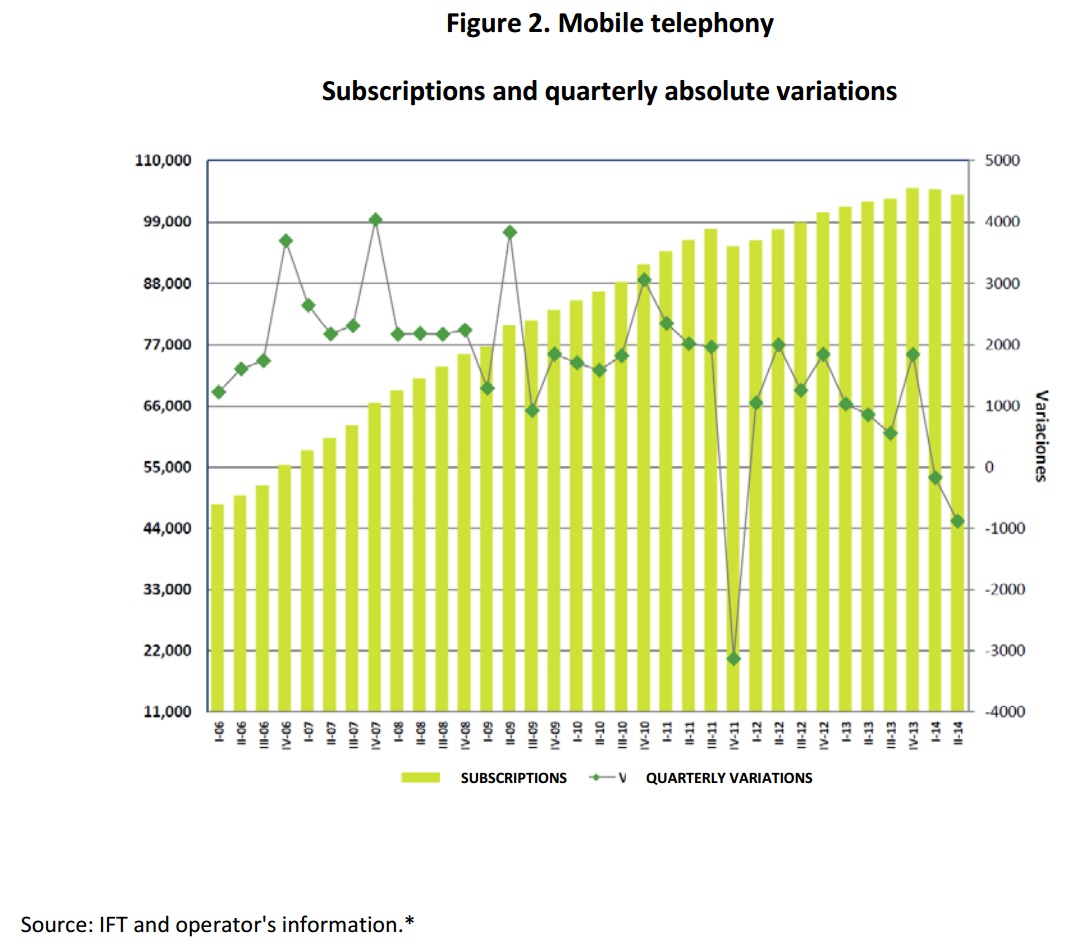
On the composition of this market by type of subscription, at the end of the second quarter of 2014, 16.3 million postpaid users were reported, representing 15.7% of total subscriptions. While in the prepay modality, the number closed at 87.6 million subscriptions, representing 84.3% of total subscriptions.
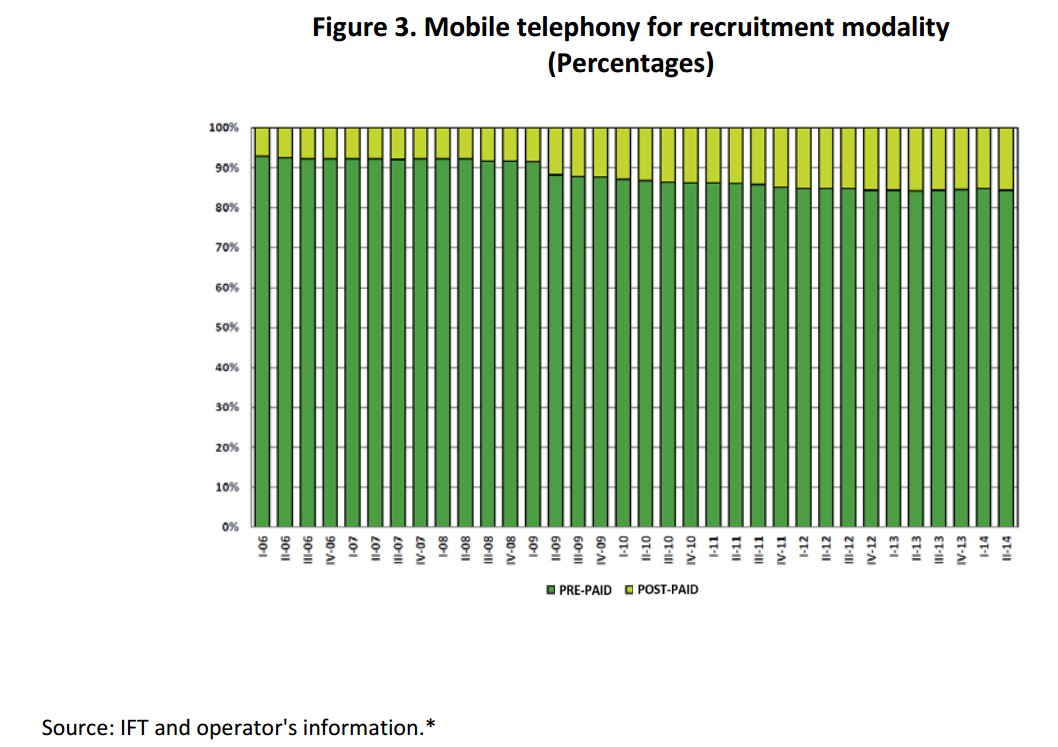
Sent messages (SMS) by mobile cellular networks, observed a decrease of 25.4% from the second quarter of 2013, equivalent to an average of 139 messages sent by subscription in the reporting period. This trend is explained largely by the use of new technologies for sending messages using data service.
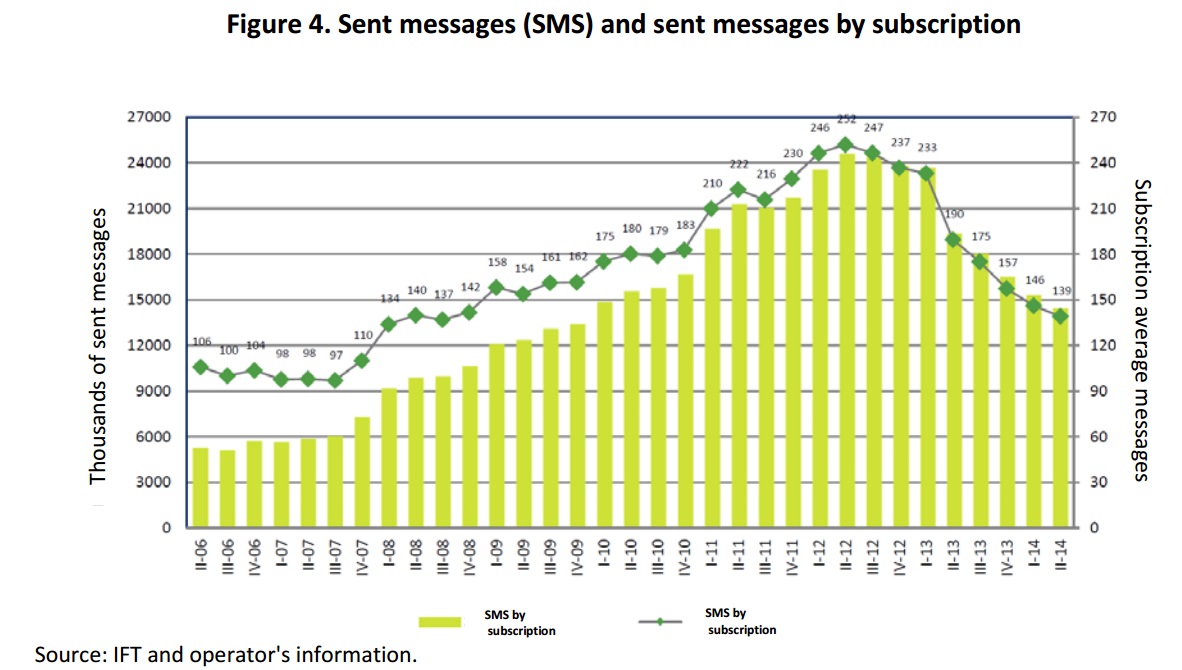
Fixed voice local telephony
At the end of the second quarter of 2014, fixed telephone subscriptions represented a total of 19.5 million, as shown in Figure 5. From the third quarter of 2013 the number of fixed telephone lines is narrowing; for the evaluated quarter represents a decrease of 3.9% over the same period in 2013 (see Figure 6). At the end of the second quarter, a density of 16.3 fixed phone subscriptions per 100 inhabitants was reached.
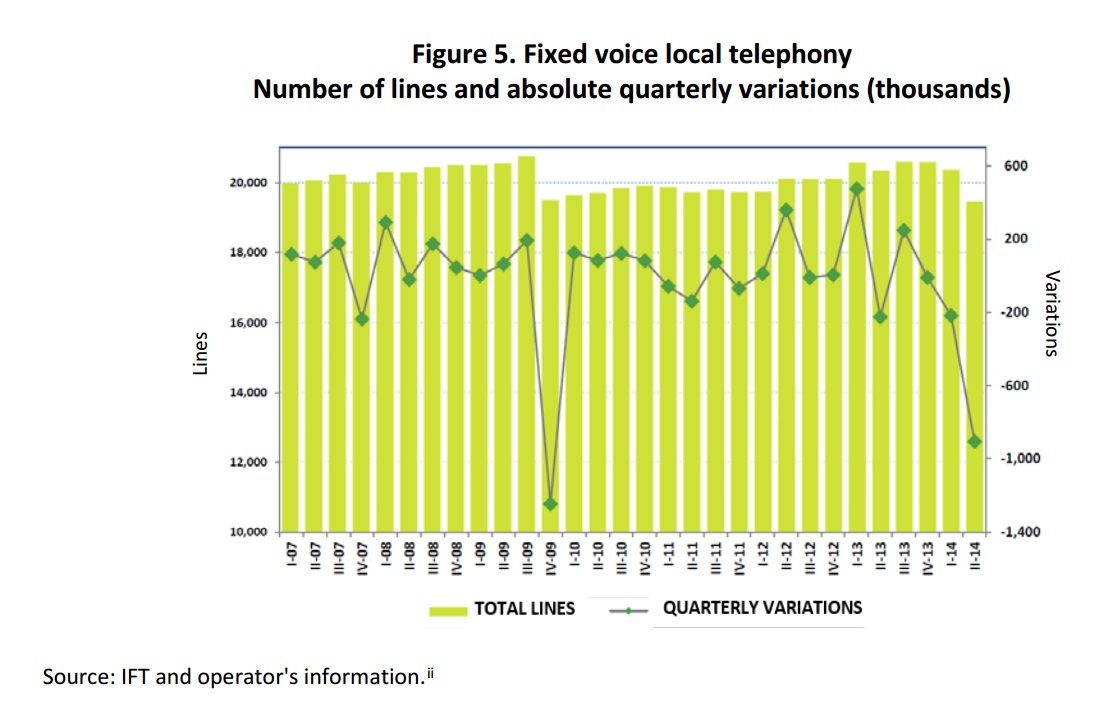
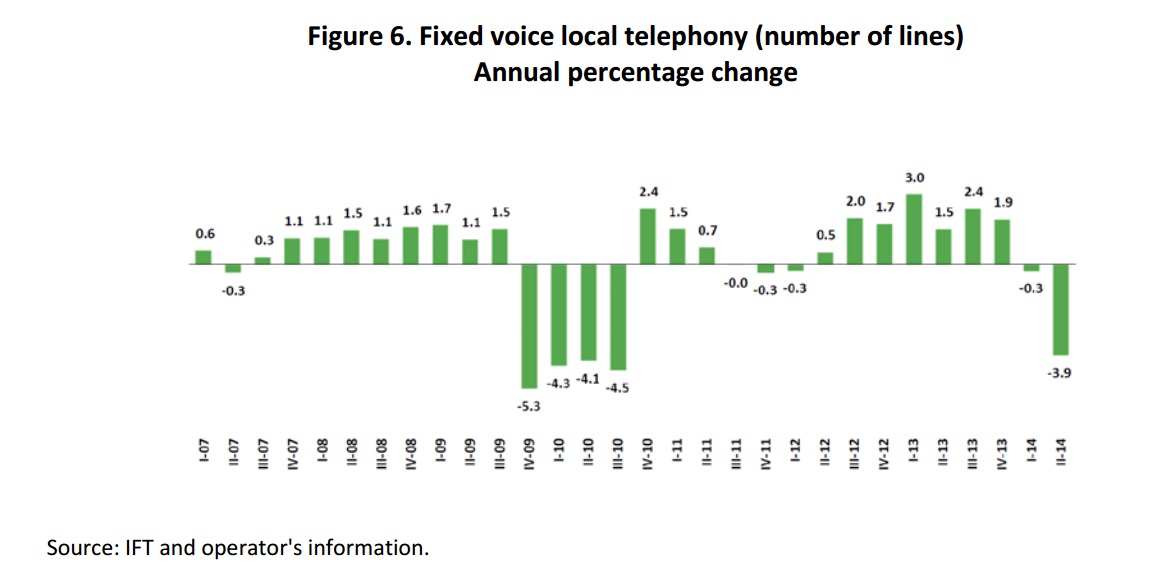
National Long Distance (NLD)
During the reported quarter, the traffic measured in minutes grew 5.9% over the same quarter in 2013 (see Figure 7). The average rate of domestic long distance telephony, recorded for the referenced quarter, it stood at 65 cents per minute, compared with 70 cents per minute of the second quarter of 2013, which continues the downward trend. With respect to national long distance, in Figure 8 an increasing trend is observed since the first quarter of 2013, generally, it could be explained by a negative correlation between traffic and the average rate (see Figure 8).
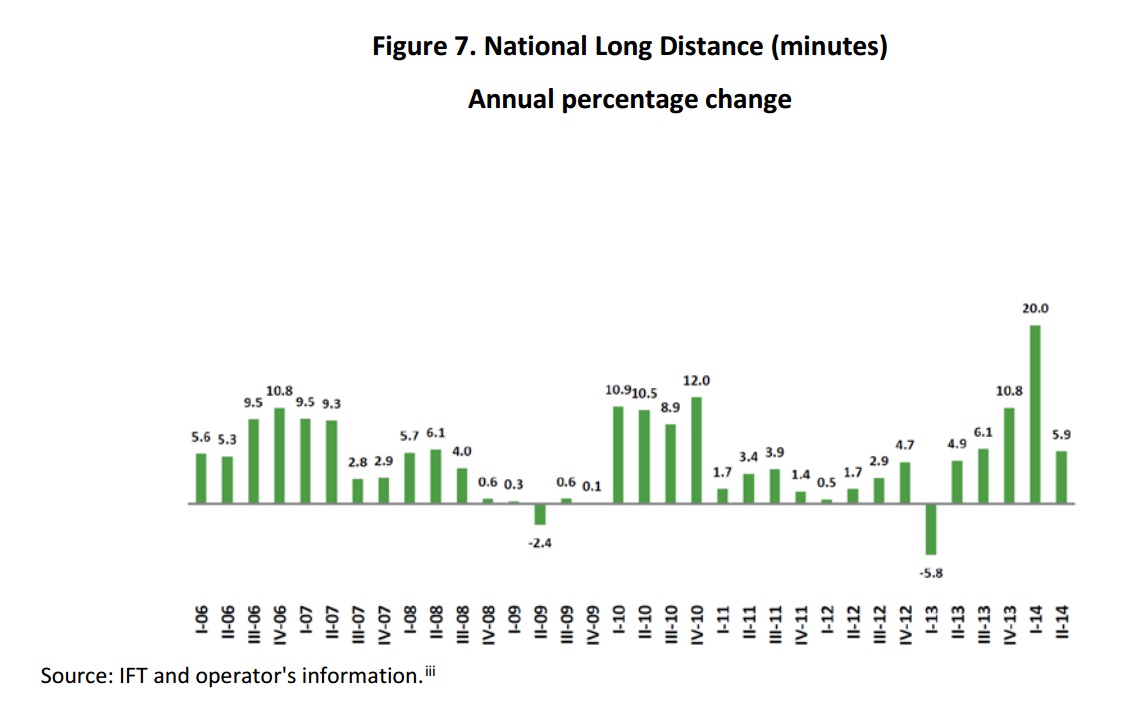
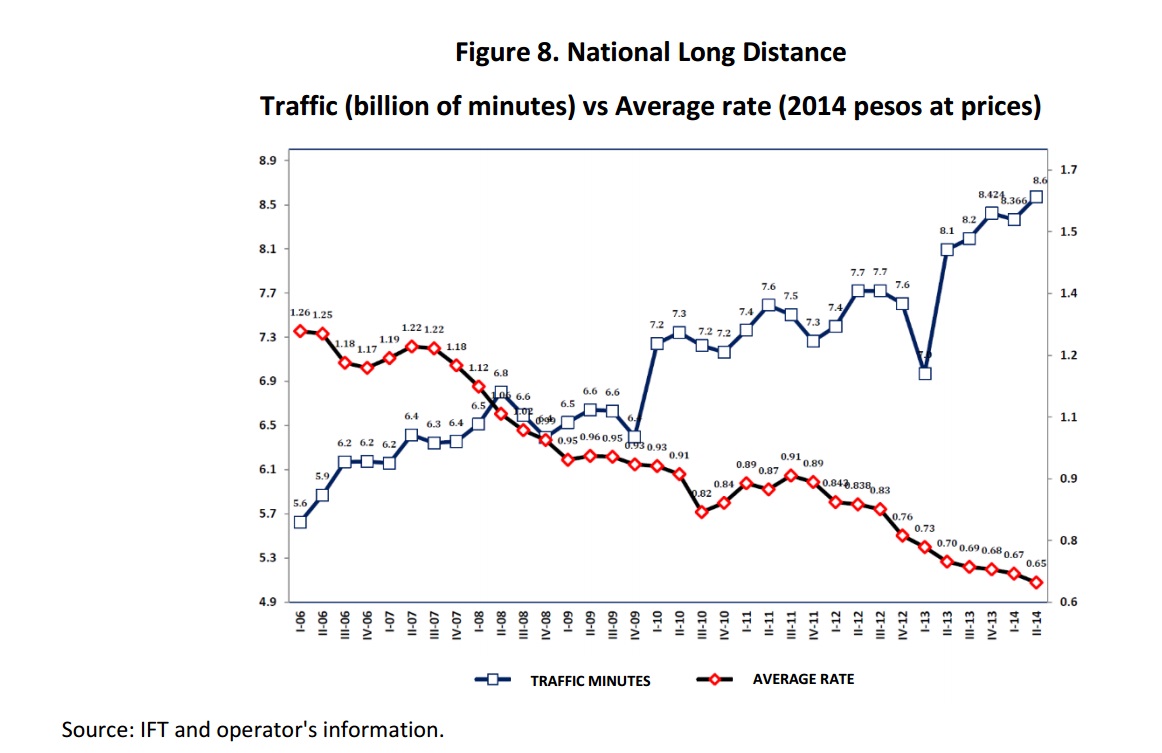
International Long Distance (ILD)
For the 2014 second quarter, minutes of international long distance input stood at 6.9 billion, representing an increase of 20.1% over the same period last year.

The minutes of international long distance had a lower output growth compared to the same quarter last year to end the quarter with an increase of 3% increase from the same period of 2013.
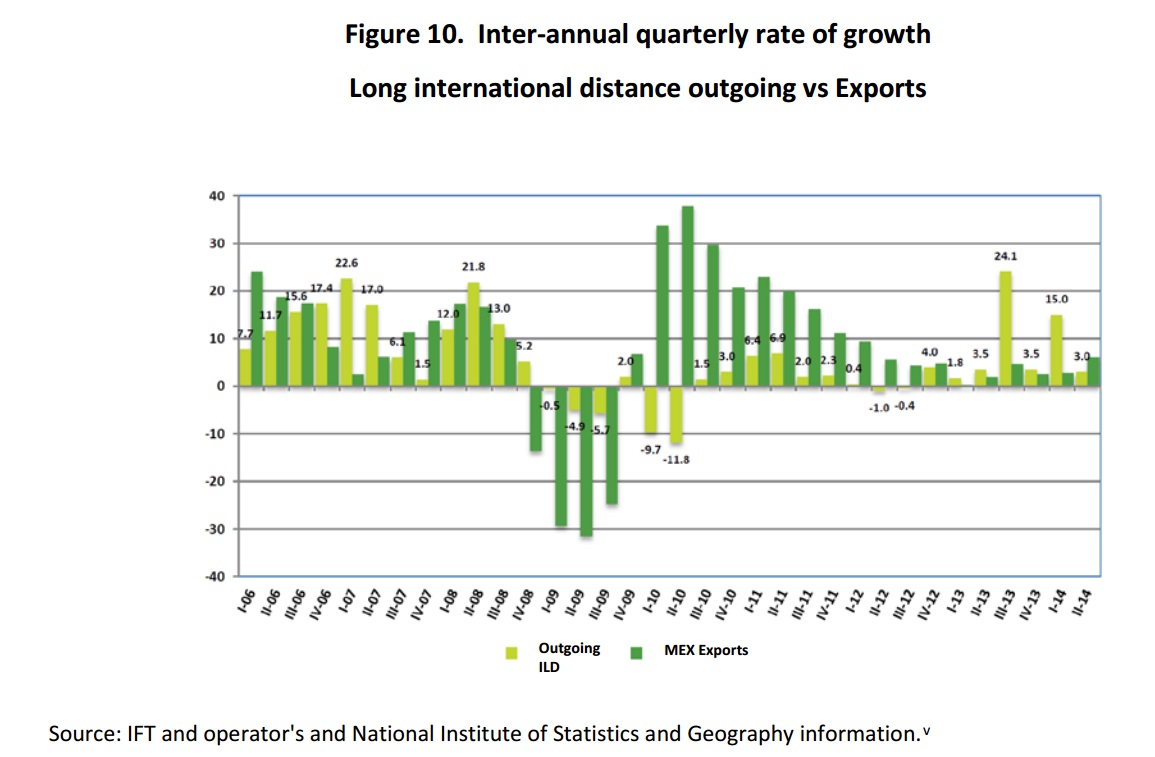
Restricted Television
The restricted television market is showing an increasing dynamism, since operators offer a wider range of tariff plans that are accessible to a greater number of people and, therefore, encompasses more sectors of the population. Subscriptions to the end of the quarter are 15.4 million. At the end of the second quarter density reached 12.9 subscriptions per 100 inhabitants. The restricted television service is offered primarily through three technologies: satellite or DTH, cable and MMDS TV or microwave. During the second quarter of 2014, the pay television service grew 6.9% over the same period in 2013.

The satellite TV service or DTH television, showed a growth of 13.79% over the same quarter of 2013. This modality for the service reached 8.3 million subscriptions at the end of the second quarter of 2014.
Restricted television noted a slowdown in growth that occurred in previous quarters, this being 0.27% as opposed to 15.53% in the same quarter of 2013. The service ended the quarter with 6.9 million subscriptions, which represent 45% of total of restricted television users.
The number of subscriptions to television services via microwave or MMDS maintains its downward trend, showing a 20% decrease compared to the same quarter of 2013. At the end of the period, this service has 122,600 subscriptions.
Trunking
During the second quarter of 2014, the number of users in the system decreased 60.1% compared to the same period in 2013, representing the largest drop since this service is measured. The number of users of this service stood at 1.3 million at the end of the second quarter of 2014, representing 1.1 subscriptions per 100 inhabitants.
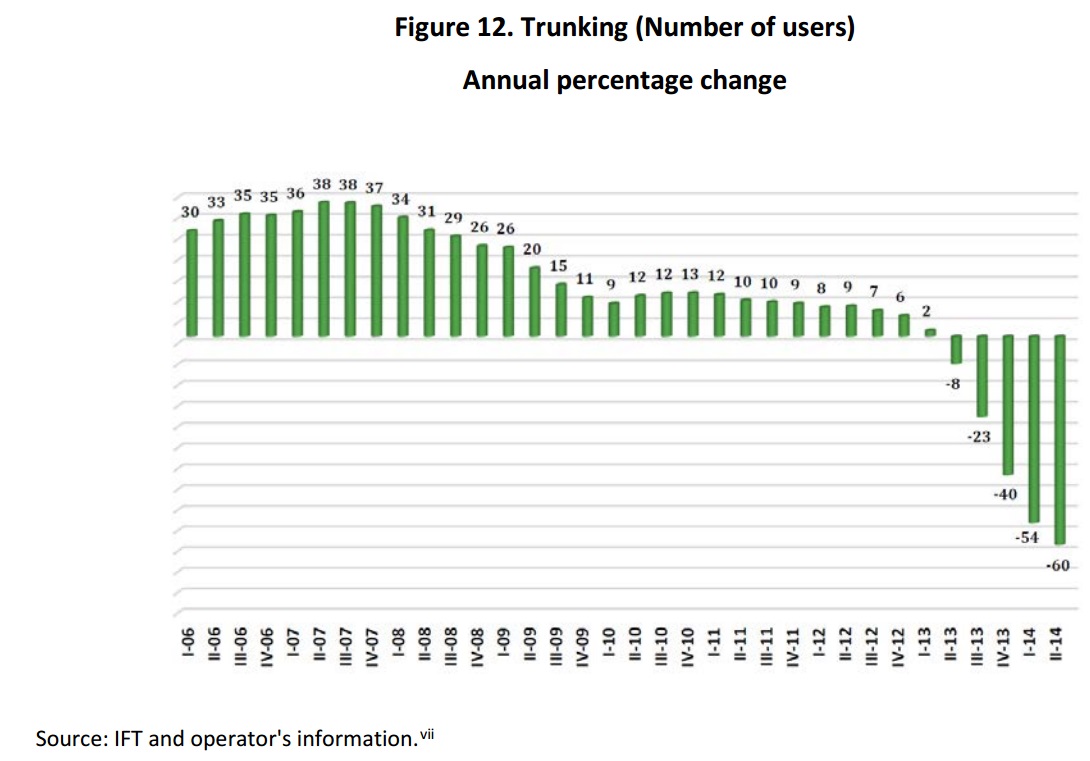
The decrease of this service is basically due to the emergence of new communication technologies resulting in a greater range of options from operators, which has led Trunking users to migrate to the last generation mobile services.
Satellite provision
In this segment is reported that the satellite provision is leased by concessionaires and includes all services as a whole. The unit of measure for the provision of satellite capacity are the Megahertz (MHz). For the second quarter of 2014, a decrease of 0.5% was recorded compared with the same quarter of 2013.
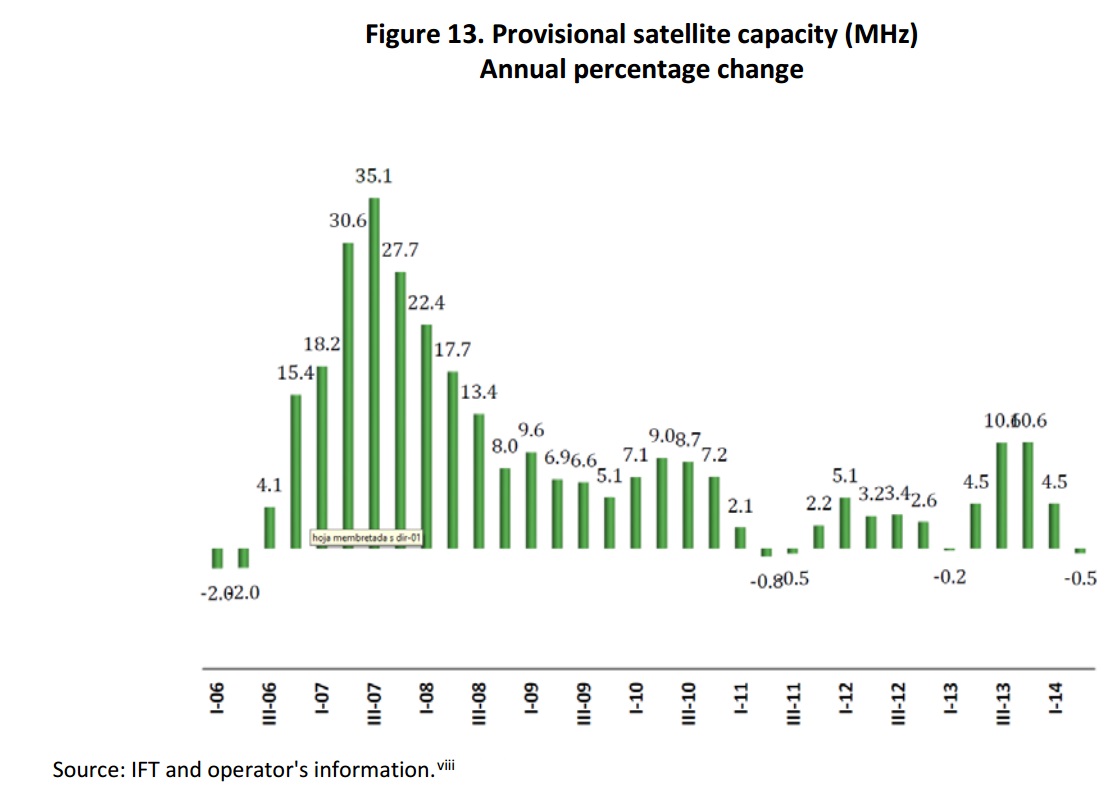
Charging evolution
The expansion of Internet services, access to technology at lower costs and competition in the telecommunications market has generated that concessionaires offer packages and promotions with increasingly attractive rates, so that they exhibit a downward trend in nominal and real terms, allowing more and more people in the country to have access to telecommunications services.
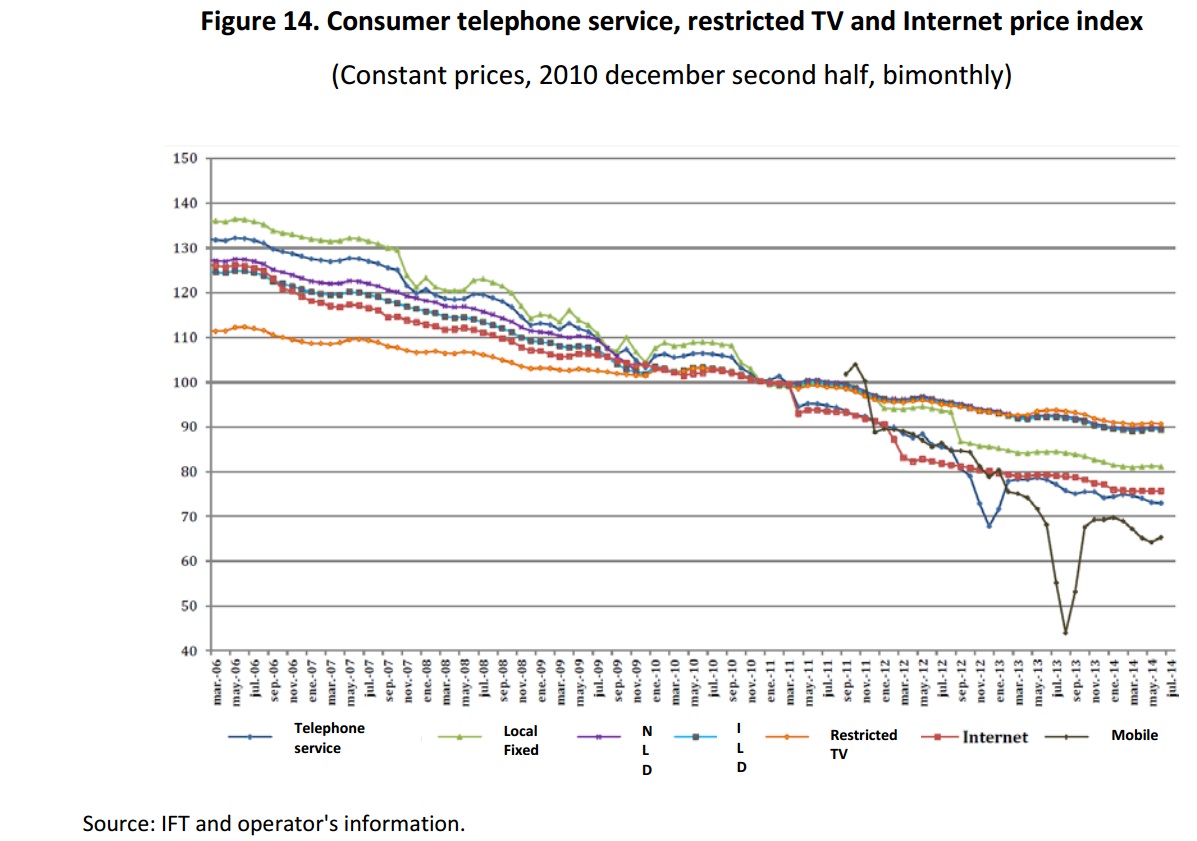
According to information from the National Institute of Statistics and Geography (Instituto Nacional de Estadística y Geografía, INEGI), prices for telecommunications services, measured based on the sub-index that make up the National Consumer Price Index (Índice Nacional de Precios al Consumidor, INPC) show significant reductions in the second quarter of 2014.
A reduction of 6.7% of Subindex Telephone Service Prices shown relative to the same period of 2013, itself consisting of a decrease of 3.9% in local service both fixed and in domestic long distance as international long distance. The largest reduction occurred in the mobile service, which was 9.1 percent.
A reduction of 6.7% on the Price Sub-index of Telephone Service is observed in relation to the same period on 2013, this is composed by a decrease of 3.9% in local fixed service and 3 % in national and international long distance and restricted television services, which was of 9.1 percent.
As a part of the Price Sub-index “Otros servicios de esparcimiento”[1] calculated by INEGI, for the second quarter, reductions on real terms are observed on a 3.2 and 4.6 per cent for restricted TV and Internet services, respectively, compared to the same period on 2013.
It is noteworthy that the measurements of prices for telecommunications services conducted by the INEGI are part of the objectives pursued by the INPC, which are measure changes over time in the general level of prices of goods and services consumed by urban households in the country. In this sense, the representativeness of their weights is focused on building a basket of goods and services that reflects the consumption house patterns.ix
i Results for the second quarter of 2014 are based on the information provided by five operators, of which one of them partially reported. Missing information was estimated according to the methodology of the Institute and using historical data.
ii Results for the second quarter of 2014 are based on the information submitted by twenty-eight operators, of which twenty of them reported information, six non-reported and two were estimated according to the methodology of the Institute and using historical data.
iii Results for the second quarter of 2014 are based on the information submitted by eighteen operators, of which seven of them reported information, six non-reporting, and five were estimated according to the methodology of the Institute and using historical data.
iv Results for the second quarter for 2014 are based on the information submitted by twenty-two operators, of which ten of them reported information and twelve did not report for the period in question.
v The results obtained for the second quarter of 2014 are based on the information submitted by twenty-two operators, of which sixteen of them reported information, five have not reported for the period in question and one was estimated according to the methodology of the Institute and using historical data.
vi The results for the second quarter of 2014 are based on the information submitted by six hundred ninety-five operators, of which two hundred and ninety of them reported information, do not report one hundred thirteen and two hundred ninety-two were estimated according to the methodology Institute and using historical data. vii Results for the second quarter for 2014 are based on information submitted by sixteen operators, of which six of them reported information, six non reported for the period in question and four were estimated according to the methodology of the Institute and using historical data.
viii Results for the second quarter for 2014 are based on information presented by eight operators, which four of them reported information two did not report for the period in question and two were estimated according to the methodology of the Institute and using historical data.
ix Further explanation can be found in the methodological INEGI documents, which can be consulted in http://www.inegi.org.mx/est/contenidos/proyectos/inp/Default.aspx.
NOTE: The results obtained in this paper emanate from data and estimates of IFT operators.
Documentos para descargar
Temas relacionados
Programa Anual de Trabajo 2015
La Reforma de Telecomunicaciones de junio del 2013 abrió la oportunidad de construir un marco regulatorio alineado al interés público, cuyo objetivo es alcanzar los equilibrios cooperativos que generen un mayor bienestar social. La razón fundamental para modificar el marco regulatorio fue establecer las condiciones iniciales para facilitar el uso óptimo de recursos en los sectores de las Telecomunicaciones y la Radiodifusión (TyR).






